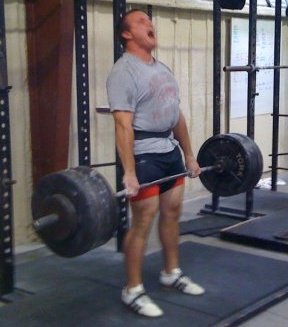In case some of you noobs haven’t seen it, I’ve talked extensively as to why you should wear a belt (part 1 and part 2).
To review, when you lift, you take a big breath. This large breath increases your intra-abdominal and thoracic pressure which acts as a pneumatic brace on the anterior portion of your spine. In other words, it helps support the spine, and because it has more support, it has more strength. This process is called the Vasalva Maneuver. The Vasalva Maneuver was something that Antonia Maria Vasalva created to test patency in the eustachian tubes of the ear. It was later used on U-boats, and has since been used by fighter pilots so that they can pull G’s as they shoot down bandits and destroy things. It’s also one of those things embedded in mammalian DNA; take a breath and hold it to exert lots of force.
Grunting while lifting achieves the same thing. The grunting provides a guttural expulsion of air through the throat against a closed glottis. Usually it is done through the sticking point, or the point where the most force is being applied because it temporarily increases the torso pressure because of the forced air against the closed glottis. But grunting should only be done on lifts over 400 pounds so that you don’t look like a jackass.
A properly tightened belt will augment all of this pressure build up. The tightness of the belt essentially decreases the volume of the lower torso just a little bit. We all know, or should know, that when the volume is decreased with the same amount of air in the container, the pressure will increase. But, more importantly than the change in volume is that the tightness forces and allows the abdominal muscles to contract harder into the belt. More contracting by the abdominal muscles with a smaller container means more pressure, thus more support, thus more strength. This is good for getting stronger, and as I’ve said before, if someone aims to get strong and doesn’t wear a belt, they are a fucking idiot.
Now, this whole “belt wearing” process has both acute and chronic affects. It irritates the shit out of me how fanboys around the internet will ask, “How many pounds/kilos will be added to my lifts if I wear a belt?” It doesn’t work quite like that. Yes, the acute affect of the belt is more pressure which leads to a stronger torso in that bout of lifting, but wearing a belt must be learned, and the belt is more useful for it’s chronic affect. Since the belt aids in strengthening the trunk, the squat/press/deadlift will be increased by wearing it over time. It will be increased so much that your new strength attained by wearing the belt will be higher than the strength you would have gained without the belt. Yes, you will get more strong more efficiently when wearing a belt.
It also has a chronic affect on the abdominals. Since they are contracting harder while tightened in a belt, they will increase in strength faster by doing so. The stronger abdominals make a stronger back as well as a stronger lift. This is also why it would be optimal to train with belts whenever possible. If you can’t wear a thick 13mm belt while deadlifting, find one that you can use. The picture below shows Chris deadlifting 625 last year wearing just a velcro belt. He has since switched to a thicker belt.
I wear a velcro belt when I clean and jerk heavy, but when I front squat I wear the same belt I back squat in because I want more tightness on my abdominals for the training adaptation. So, don’t think in terms of acute use out of wearing belts, because the chronic adaptation of wearing one over time while getting your abdominals stronger is the most useful reason to wear it.
Breakin in that stiff belt from 70s Big on Vimeo.


Pingback: OFFICIAL WORKOUT/TRAINING THREAD v2.0 - Page 1158 - Vancouver's Top Classifieds and Automotive Forum - REVscene.net